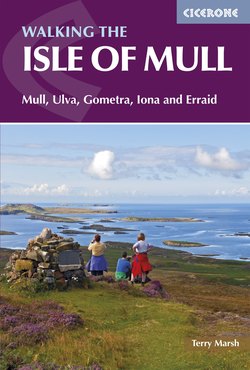Читать книгу The Isle of Mull - Terry Marsh - Страница 13
На сайте Литреса книга снята с продажи.
ОглавлениеWALK 1.2
Rubha nan Gall
| Start | Tobermory car park (NM 505 551) |
| Distance | 5.2km (3¼ miles) |
| Ascent | 180m (590ft) |
| Terrain | Woodland paths across steep slope; golf course |
| Map | OS Explorer 374 Isle of Mull North and Tobermory |
The brightly coloured houses of Tobermory are a delightful prelude to this mainly woodland walk to the lighthouse at Rubha nan Gall, the Headland of the Stranger. Although you can simply return the same way, there is an agreeable alternative that climbs up onto the headland and then treks around the edge of Tobermory’s lumpy but beautiful golf course.
Tobermory, the main town on Mull, takes its name from the well and chapel of St Mary, although no-one seems to know precisely where (somewhere below the cemetery) the well is located. What remains of the chapel is found in the old part of the cemetery. The town was established in 1788 by the British Fisheries Society, although fishing never prospered here, in spite of the sheltered nature of the bay.
Walk to the far end of Tobermory, to the ferry point, and look for a path rising on the left just after the last building. This climbs easily, and soon wanders into light woodland, and then by a generally level path through a tunnel of trees around the edge of the bay.
At NM 511 565, the track divides. You will return to this point, but for now bear right and follow an improving, but sometimes muddy, path that suddenly breaks free of the woodland. Now, cross a steep slope covered with heather, bracken, gorse and birch, with a lovely view across the Sound of Mull to Ardnamurchan. Soon, the lighthouse at Rubha nan Gall comes into view, seemingly hunkered down among the rocks, until you get closer and see that it lies at the end of a small pier.
Just before reaching the light, there are steps on the right down to a memorial viewpoint, commemorating Robert John Brown, who lived close by in Tobermory, and whose father, Archibald, founded Browns shop in Tobermory. This is a useful place to spend a few minutes identifying distant landmarks, not least the squat triangle of Ben Hiant across the sound.
Press on along a clear path to reach the former lighthouse keepers’ cottages at Rubha nan Gall and the lighthouse, first lit in 1857, and automated in the 1960s. Going further, beyond the light, takes you into difficult terrain, and is not advised.
Lighthouse, Rubha nan Gall
Tobermory
Northwards lies so-called Bloody Bay, where in 1480 a great sea battle took place between John, the last Lord of the Isles, and his son Angus. On that day the tide came ashore red with blood. And, as Jim Crumley explains in The Heart of Mull, so it is that the oystercatcher owes its red beak and legs to its forebears who waded along the shore on that fateful day.
Retrace your steps to the point where the path divided, and there turn right, climbing easily through the woodland to reach its upper rim at an iron fence stanchion. Here turn left, pursuing a pleasant path above the upper limit of the woodland, undulating gently upwards through bracken to reach a step-stile at the edge of Tobermory golf course.
Cross the stile and keep left, following the manicured edges of the golf course, a splendid experience when stray golf balls are not flying in your direction. Keep on, with lovely views of Calve Island, until a path takes you away from the course edge, descending for a while, but then emerging back onto the golf course edge. Continue beyond the fifth green, and then ultimately the fifth tee, after which a path leads to an iron gate in a corner.
Through the gate you enter a neck of woodland, and in a few strides turn left to follow a clear path round the edge of Bad-Daraich house to a road head at Oakfield (NM 509 555). Now turn left, and when you reach the war memorial, turn left beside it, taking a descending path and steps that lead to the path used at the start of the walk. Turn right to return to the edge of Tobermory at the Calmac pier.
SUNKEN TREASURE
Those who enjoy a good yarn may find appeal in the story that an Armada galleon carrying untold treasure was destroyed close by the pier in 1588, and that great wealth, if you can find it, lies deep in the silt of the bay. There are numerous versions of the story, and of the ‘detail’ of how the galleon was blown up just as it was readying to sail. The most charming is that the Witch of Lochaber, engaged by Lady Maclean of Duart Castle to retrieve her husband from the attentions of a beautiful Spanish princess on board the galleon, called up an army of fairy cats, which swam out and savaged the crew. One, in pursuing a sailor, set off loose powder in the magazine with sparks from its fur, and so destroyed the galleon. While there can be little doubt that such a tale is perfectly true, Alison MacLeay gives an alternative version in The Tobermory Treasure, to which contemporary thinking ascribes greater veracity. The wreck was long thought to have been the man-of-war, the Florencia, but was, in fact, a Mediterranean carrack, the San Juan de Sicilia.
Ardmore Bay
